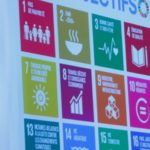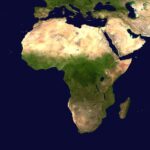ABSTRACT
The vulnerability of the Nigerian economy to the fluctuating rates of crude oil in the international market, high levels of unemployment, and insufficient power supply are all starting to weaken the strength of the government’s response to the expected devastating effects of climate change. To address this imminent catastrophe, this research sought to identify the most critical actions needed to build a more sustainable and circular economy in Nigeria as a preventive response to the impacts of climate change. The achievement of the United Nations Sustainable Development Goals (SDGs) is expected to build a sustainable economy that mitigates climate change impacts. But this requires a strong determination from the Government and the adoption of a coordinated set of actions targeted at the indicators that form the goals. This study was conducted to identify the major factors to be considered for inclusion in an action plan for the transition to a circular economy in Nigeria. Adopting a qualitative research method using interviews and document reviews, this research found that waste reduction through recycling and the adoption of sustainable public procurement are two potent factors towards achieving SDG 12-Sustainable Consumption and Production. They showed a significant impact on the transition to a circular economy and the achievement of SDG-12 in Nigeria. Therefore, this research recommends the formulation of an enforceable legal framework and massive awareness campaigns for the achievement of SDG-12 in Nigeria.
INTRODUCTION
The slow progress with SDG 12, Nigeria’s energy crisis and bumpy road to renewables growing ecological overshoot and worsening climate change, unsustainable patterns of consumption and production, Nigeria’s waste management crisis, global food loss, and food waste levels, global population growth, and resource use, and the broad global circularity gap have continued to pose a significant risk to achieving the SDGs in Nigeria before the 2030 target date. Also, recent research pieces revealed that “the legal and regulatory frameworks needed to foster circularity are still in their infancy in most African countries as mechanisms to realize the transition towards green economies are often not in place”.[1] This is the basis for one of the research questions of this research.
Peculiar to Nigeria is the problem of mounting waste,[2] energy crisis, weak corporate commitment to sustainable business practices in production and consumption, low recycling levels, and poor public procurement governance. To achieve the United Nation’s SDG 12- Sustainable Consumption and Production in Nigeria, we need to recycle more and adopt a sustainable public procurement system. To achieve these two cardinal targets, this study has found a need for an enforceable legal framework, massive enlightenment campaigns, monitoring and reporting, stakeholders’ engagement, extended producer responsibility, recycling infrastructure, capacity building, and market engagement, among other factors.
This research set out to identify the critical actions that must be taken to reduce waste generation and achieve more recycling towards sustainable production and consumption. The researcher conducted qualitative research using the grounded theory approach. In this approach, interviews were conducted, relevant documents were reviewed, and some case studies were done. This research found that the most critical factors required to manage waste and shift to more sustainable production and consumption patterns are the establishment of a legal framework, enforcement of extended producer responsibility, the introduction of motivation and incentive schemes, creation of awareness, engagement of relevant stakeholders, strict monitoring and reporting, and provision of infrastructure.
Researches found the switch to renewable energy as a major factor driving the circular economy transition. However, when we talk beyond the transition to tackling climate effects, we need more than renewables. A recent report confirmed that “Switching to renewable energy plays a vital role in addressing climate change, but this alone will not be enough. To achieve climate targets, we must transform how we design, make, and use products and food. Completing the picture through a transition to a circular economy can enable us to meet the needs of a growing global population while creating a prosperous and resilient economy that can run in the long term”.[3]
LITERATURE REVIEW
The circular economy (CE) concept is gaining increasing relevance in the discourse of sustainable development within the business community and among policymakers, academia, and Government across the globe. The concept is gaining this attention because it is believed to have the potential of supporting the achievement of the United Nations’ set Sustainable Development Goals (SDGs). Of course, any useful solution to the pressing environmental, economic, and social challenges of the present and future generations must be embraced and applied.
Some documents reviewed highlighted the importance of guidelines to help give countries how they could address the transition to a circular economy through plastic waste recycling. Because of this, the United Nations Environment Programme (UNEP), the International Union for Conservation of Nature (IUCN), and the Life Cycle Initiative co-developed a ‘National Guidance for Plastic Pollution Hotspotting and Shaping Action’.[4] The Guidance aims to provide a methodological framework for identifying plastic leakage ‘hotspots’, finding their impacts along the entire plastic value chain, and then prioritizing actions once these hotspots are identified. The Guide aims to assist countries, regions, or cities in making the right decisions in their environments and establishing a baseline for benchmarking and tracking the progress of interventions. This research found that it is vital for countries to have national action plans to guide them into the critical factors necessary to achieve the SDGs.
There has been large scale campaign and publicity actions towards creating the enlightenment that is needed to achieve a behavioral change towards more sustainable practices and lifestyles in Nigeria and across the globe. This is still too low in Africa compared to regions like Europe, Asia, and the Americas. Clearly, in Nigeria, the transition to a circular economy has not been sufficiently embraced nor practiced. This, in effect, means that the opportunities inherent in a circular economy are still untapped for the achievement of sustainable development.[5]
With technological innovation, rapid urbanization, and economic growth in developing economies like Nigeria, we are faced with a growing number of electronic waste (e-waste). Nowadays, many urban households own more than one telecommunication and electronic devices. With the life cycle of these pieces of equipment becoming shorter as newer ICT products are launched, we are bound to tackle more e-waste in the future. It was estimated that 48.5 million tons of e-waste were generated in 2018, with only 20% adequately managed. It has also been projected that the number of e-waste will go up to 52.2 million tons in 2021. The imminent calamity to our environment posed by e-waste calls for urgent action on recycling and a new approach to e-waste management.[6]
In Nigeria, more than half a million tons of discarded electronic appliances are accessed and processed annually, according to the United Nations Environment Programme (UNEP). With the several tons of e-waste that find their way to Nigeria en route to neighboring countries, over 25% of this e-waste is classified as dead on arrival and heading straight to dumps or for dismantling. Eventually, this waste is often burned, releasing heavy metallic and toxic chemicals into the air, soil, and water.
The concept of the circular economy is increasingly gaining traction in developing countries and emerging economies. Some Governments in Africa, including Rwanda, Nigeria, and South Africa have launched the African Alliance on Circular Economic since 2017. One of the outcomes from the 2017 Summit of the EU and the African Union (the “Abidjan Declaration”) was recognizing the circular economy model as a high potential for sustainable job creation, low emissions, climate change resilience, and sustainable development. Following these commitments, the Declaration of the African Ministerial Conference on the Environment in November 2019 underlined and reinforced the seriousness of African countries’ in adopting and promoting the circular economy approaches in Africa.
NIGERIA’S COMMITMENT AND EFFORTS TOWARDS A CIRCULAR ECONOMY
Reviewing recent research and publications on Nigeria’s commitment to achieving the SDGs, this research can confirm that the Nigerian Government has shown some determination in achieving success with the Sustainable Development Goals (SDGs) as a means towards building an inclusive economy that generates jobs and reduces poverty and hunger. For instance, the recently unveiled 2020 Voluntary National Review (VNR) on Sustainable Development Goals (SDGs) focuses on the critical issues of poverty (SDG-1), an inclusive economy (SDG-8), health and wellbeing (SDG-3), Education (SDG-4), Gender equality (SDG-5), the enabling environment of peace and security (SDG-16), and partnerships (SDG-17).[7]
These goals can also be traced to the national development plans like the Nigerian Economic Recovery Growth Plan (ERGP) and the more recent Economic Sustainability Plan unveiled by President Muhammadu Buhari’s administration. More needs to be done to bring other goals into focus, like the SDG 12 on Sustainable Consumption and Production. This also points to the need for a well-articulated action plan to transition to a circular economy towards the achievement of the SDG 12 in Nigeria.
Working towards a transition to a circular economy and addressing some of Nigeria’s identified environmental and health challenges, the Circular Economic Approaches for the Electronics Sector in Nigeria Project[8] was launched recently. The Project will bring together the government, private sector, and civil society to initiate a self-sustaining circular economy approach for electronics that protects the country’s environment and create safe employment. “The project aims to collect, treat and dispose of over 270 tonnes of e-waste contaminated with persistent organic pollutants (POPs), as well as 30 tonnes of e-waste containing mercury”.
Another effort of the Nigerian Government in succeeding with the SDGs is the attempt to integrate the SDGs into national planning. For instance, there has been an ongoing realignment of the National Statistical System (NSS) with the SDGs’ requirements, targets, and indicators. By this, some SDGs components will form the basis of policies and strategies in the coming years. Nigeria, working with the Millennium Institute, has developed a domesticated ‘Integrated Sustainable Development Goals (iSDG Model) – an analytical framework designed to assess the impact of policies on the SDGs’ achievement across all relevant sectors. This gives room for a methodological and systemic evaluation of the progress made with the SDGs.
In addition to the efforts above, Nigeria’s 2020 VNR report has drawn on past evaluations across the Seven priority SDGs. It has an ongoing evaluation of the country’s performance in some SDGs. This attempt to systematically use evaluations is an innovation in the VNR context. Nigeria should strengthen the evidence-based planning and accountability mechanisms at the State level in accelerating the SDGs in this decade of action. The post-ERGP National Development Plan (2021-2030) will be pivotal in advancing the SDGs’ achievement in Nigeria.
According to the Millennium Institute, “the Integrated Sustainable Development Goals (iSDG) model is a policy simulation tool designed to help policymakers and other stakeholders make sense of the complex web of interconnections between the SDGs. Unlike databases and indexes that provide a measure of where a country stands, iSDG focuses on the dynamic interactions within the SDG system to reveal the best paths and progression towards achieving the SDGs”.[9] The Integrated Sustainable Development Goals (iSDGs) policy simulation model was recently launched in Nigeria as a useful addition to the existing family of development planning tool kits.
Like many African countries, one major challenge confronting the country today is how to achieve policy coherence by aligning national plans and budgets. Strengthening the collaboration between the various government tiers (Federal, State, and Local Government in this case) towards improved budget implementation for better delivery of public services is another one. Integrated simulation tools assist policymakers in system-wide policy planning. Such tools or models may be considered bookkeeping units where feedback structures have been identified and translated to conceptual maps and equations that capture dynamic behavior. Accompanied by scientific insights about various relationships and enriched by data, models can be seen as policy ‘flight simulators’.[10]
In Nigeria, the Office of the Senior Special Assistant to The President on the SDGs is charged with Inter-governmental coordination of the SDGs implementation, planning, multi-stakeholders’ partnership, and resource mobilization, as well as ensuring seamless and robust strategic communications and advocacy around the SDGs Agenda. It was reported that this Office has been “working with the Ministry of Budget and National Planning and UNDP on the SDGs Needs Assessment and Costing. This exercise will allow sectoral costing of all the interventions required to achieve the SDGs, and when concluded, Nigeria will have a clear estimate of what it will cost to achieve the SDGs. This information will help us align the mid-term strategies of the MDAs to government’s fiscal framework and the national budget”.[11]
KEY FINDINGS ON ACHIEVING SDG12 IN NIGERIA
The SDG 12 set of indicators and targets sets the definition of scope for this research. This research has helped identify the most critical factors, regulations, and policies[12] required to achieve the most critical factors, regulations, and policies as reflected in the two targets of SDG 12. They are:
12.5. By 2030, substantially reduce waste generation through prevention, reduction, recycling, and reuse.
12.7. Promote public procurement practices that are sustainable, following national policies and priorities
Individuals, companies, and government agencies’ actions relating to the use of resources in Nigeria starting from 2015 and targeting 2030 set the boundaries for this research inquiry. The researcher looked at what had happened since the Sustainable Development Goals (SDGs) were adopted in 2015 and what must be done concerning SDG 12.5 and 12.7 to transit to a circular economy in Nigeria. This research also acknowledges that achieving the SDGs would require peculiar activities related to different countries’ development profile. Countries at different development levels [13] require different policies, regulations, and standards to achieve the SDGs.
From responses to the interview questions on how to encourage more recycling (SDG 12.5), the researcher generated major keywords and themes like behavior change, awareness campaigns, enforcement, regulations, penalties, incentives, recognitions/awards, legal framework, infrastructure, technology, public-private partnerships, regulatory agencies, government, companies, waste market, lack of export markets, circular business models, not-for-profit, extended producer responsibility, stakeholders’ engagement, school curricula, research & development, product design innovation, packaging, recycling fund[14], licensing and permits, tax rebates, et cetera.
The second target, SDG 12.7, talks about implementing sustainable public procurement. This research identified six major themes that emerged from the responses to this research question. The major themes that emerged from the transcripts through coding and categorization are legal framework enforcement, awareness campaigns, capacity building, market engagement, and monitoring and reporting. In Nigeria, the Public Procurement Act 2007 established the Bureau of Public Procurement[15] charged with the responsibility to, amongst others, provide Legal and institutional framework and Professional Capacity for public procurement in Nigeria. How to enforce the established legal framework came up as one of the challenges identified in this research.
CONCLUSION
Findings on required actions for a reduction in a waste generation through recycling showed that 31% of the factors were on the formulation of a legal framework to guide Nigeria’s implementation of a waste reduction program. This research has concluded that the most critical factor for waste reduction and recycling in Nigeria is establishing a legal framework to drive such an initiative. Another conclusion from this research is that companies have a lot to do to take responsibility for their products’ environmental impact from manufacturing to consumption and recycling for reuse. This conclusion derives from a score of 19% of respondents’ issues to what actions are needed for waste recycling. The other factors raised by respondents to be responsible for waste reduction and recycling are infrastructure, motivation, and awareness campaigns have all represented about 15% of each of the issues. The research has also concluded that stakeholders’ engagement is essential to obtain the cooperation needed to drive Nigeria’s waste reduction program. This represented about 4% of the issues raised by respondents.
On the implementation of sustainable public procurement in Nigeria, this research, based on findings, has concluded that establishing a legal framework is the most critical factor. Findings from respondents’ information and reviewed documents showed that 33% of the issues were around the need for a legal framework. Next to this is the factor of monitoring and reporting, which represented about 23% of the issues. The conclusion here is that even with a legal framework in place, there will be little or no success with implementing sustainable public procurement without strict monitoring and reporting on compliance.
Another major conclusion from this research is that, for a successful shift to more sustainable procurement, market actors must be engaged throughout the process of the shift. Without the cooperation of suppliers, manufacturers, and intermediaries in the supply chain, a sustainable public procurement shift will not be possible. The issues raised by respondents that fell under market engagement account for about 20%, ranking third among the five major themes. And of course, the remaining two major themes are capacity building and awareness creation ranking 13% and 10%, respectively. Another conclusion is that public officers must be trained to drive the shift to sustainable practices in public purchases. Yet another conclusion from this research is that awareness plays a significant role in achieving any behavioral shift.
This research, based on the findings and conclusions, recommend that to transit towards a circular economy and achieve sustainable consumption and production (SDG-12) in Nigeria, we must establish an enforceable legal framework; adopt a Public-Private Partnership model to finance required infrastructure; create awareness through the most popular media platforms (using the social, print and electronic media and agencies of government responsible for creating public awareness); establish a standard template for monitoring and reporting on compliance, and design and implement a well-coordinated incentive system and a whistle-blowing program. This research implies that the United Nations’ SDG-12 (Sustainable Consumption and Production can be achieved through the transition to a circular economy in Nigeria.
REFERENCES
- Desmond P, Asamba M. Accelerating the transition to a circular economy in Africa. In 2019. p. 152–72.
- Living in Dirt: Nigeria’s waste crisis requires urgent action [Internet]. Nigeria Health Watch. 2019 [cited 2020 Nov 10]. Available from: https://nigeriahealthwatch.com/living-in-dirt-nigerias-waste-crisis-requires-urgent-action/
- How the circular economy tackles climate change [Internet]. [cited 2020 Dec 11]. Available from: https://www.ellenmacarthurfoundation.org/our-work/activities/climate-change
- National Guidance for Plastic Pollution Hotspotting and Shaping Action – A common methodological framework to enable countries to prioritize interventions to abate plastic pollution [Internet]. [cited 2020 Sep 5]. Available from: https://plastichotspotting.lifecycleinitiative.org/
- Ogunsanwo A, Ayo-Balogun A. Circular Economy: A Prototype for Sustainable Development in Nigeria [Internet]. Rochester, NY: Social Science Research Network; 2020 Sep [cited 2020 Nov 27]. Report No.: ID 3687567. Available from: https://papers.ssrn.com/abstract=3687567
- ITU Training on ‘E-waste Management & Circular Economy’ [Internet]. [cited 2020 Nov 27]. Available from: https://www.itu.int/en/ITU-T/studygroups/2017-2020/05/sg5rgafr/201903/Pages/default.aspx
- Nigeria: Sustainable Development Knowledge Platform [Internet]. [cited 2020 Nov 11]. Available from: https://sustainabledevelopment.un.org/index.php?page=view&type=30022&nr=2401&menu=3170
- Hub ISK. Nigerian Project Tackles E-Waste, Promotes Circular Economy | News | SDG Knowledge Hub | IISD [Internet]. [cited 2020 Nov 28]. Available from: https://sdg.iisd.org:443/news/nigerian-project-tackles-e-waste-promotes-circular-economy/
- iSDG – Integrated Sustainable Development Goals Model | Millennium Institute [Internet]. millenniuminstitute. [cited 2020 Dec 24]. Available from: https://www.millennium-institute.org/isdg
- Collste D, Pedercini M, Cornell SE. Policy coherence to achieve the SDGs: using integrated simulation models to assess effective policies. Sustain Sci. 2017 Nov 1;12(6):921–31.
- Assessing SDGs implementation in Nigeria [Internet]. Punch Newspapers. [cited 2020 Nov 27]. Available from: https://punchng.com/assessing-sdgs-implementation-in-nigeria/
- Hartley K, van Santen R, Kirchherr J. Policies for transitioning towards a circular economy: Expectations from the European Union (EU). Resources, Conservation and Recycling. 2020 Apr 1; 155:104634.
- Balogun J. Economic Recovery and Self-sustaining Development in sub-Saharan Africa: A Review of Capacity Building Implications. Africa Development / Afrique et Développement. 1997;22(2):69–99.
- EPA N. Better Waste and Recycling Fund [Internet]. NSW Environment Protection Authority. [cited 2020 Sep 5]. Available from: https://www.epa.nsw.gov.au/working-together/grants/councils/better-waste-and-recycling-fund
- CORE OBJECTIVES | Bureau of Public Procurement [Internet]. [cited 2021 Jan 2]. Available from: https://www.bpp.gov.ng/core-objectives/
Publisher information: The Intergovernmental Research and Policy Journal (IRPJ) is a unique interdisciplinary peer-reviewed and open access Journal. It operates under the authority of the only global and treaty-based intergovernmental university in the world (EUCLID), with other intergovernmental organizations in mind. Currently, there are more than 17,000 universities globally, but less than 15 are multilateral institutions, EUCLID, as IRPJ’s sponsor, is the only global and multi-disciplinary UN-registered treaty-based institution.
IRPJ authors can be assured that their research will be widely visible on account of the trusted Internet visibility of its “.int” domain which virtually guarantees first page results on matching keywords (.int domains are only assigned by IANA to vetted treaty-based organizations and are recognized as trusted authorities by search engines). In addition to its “.int” domain, IRPJ is published under an approved ISSN for intergovernmental organizations (“international publisher”) status (also used by United Nations, World Bank, European Space Agency, etc.).












